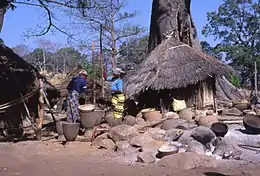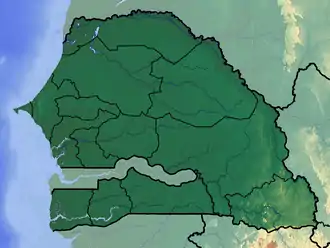Bassari Country
The Bassari Country and its Bassari, Fula and Bedik Cultural Landscapes, located in the southeast of Senegal, is a well-preserved multicultural landscape which emerged from the interaction of human activities and the natural environment. It aggregates three geographical areas: the Bassari–Salémata area, the Bedik–Bandafassi area and the Fula–Dindéfello area, each one with its specifics morphological characteristics.[1]
| UNESCO World Heritage Site | |
|---|---|
 Bedik village | |
| Location | Senegal |
| Includes |
|
| Criteria | Cultural: (iii), (v), (vi) |
| Reference | 1407 |
| Inscription | 2012 (36th session) |
| Area | 50,309 ha (124,320 acres) |
| Buffer zone | 240,756 ha (594,920 acres) |
| Coordinates | 12°35′36″N 12°50′45″W |
 Location of Bassari Country in Senegal | |
In 2012, the Bassari Country with its Bassari, Fula and Bedik Cultural Landscapes was added to the UNESCO list of World Heritage Sites.[2]
See also
References
- "Bassari Country: Bassari, Fula and Bedik Cultural Landscapes". UNESCO. Retrieved 16 May 2015.
- "Twenty-six new sites inscribed on UNESCO World Heritage List this year". UNESCO. Retrieved 16 May 2015.
This article is issued from Wikipedia. The text is licensed under Creative Commons - Attribution - Sharealike. Additional terms may apply for the media files.
